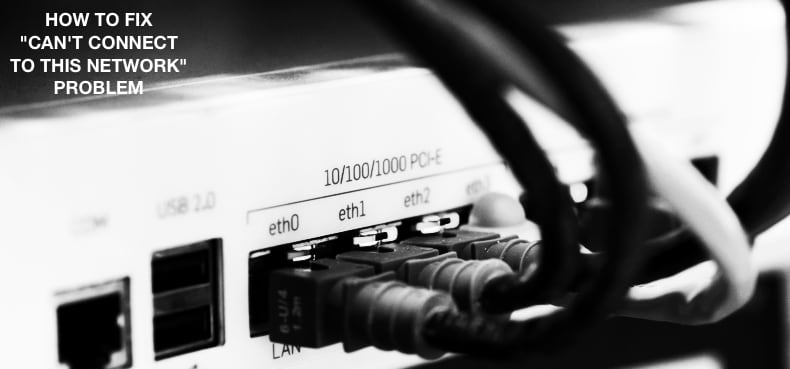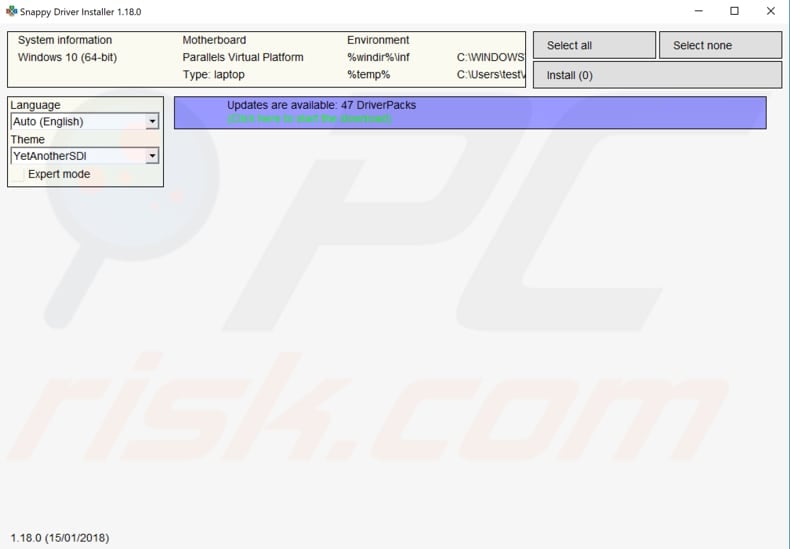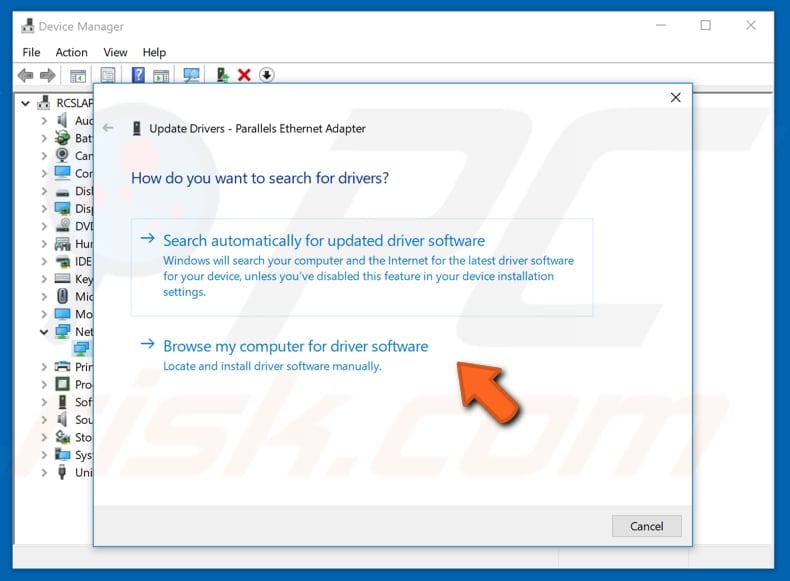How To Fix Can’t Connect To This Network Problem On Windows 10
In 1995, only about 1% of the world’s population was online. Twenty years later, more than three billion people, nearly half of the planet, have an Internet connection. These days, being unable to connect to the Internet can be frustrating and make you feel like you are back in 1995. If you are using the Windows 10 operating system and receiving an error such as „Can’t connect to this network“, then you know how this feels. There are several reasons why your computer might not connect to a particular network – this is not a new problem to Windows users, and the good news is that it can easily be fixed.
There might be something wrong with your network adapter or associated driver (the error could be caused by an old or incorrect network driver). In this case, try to update or install a different (correct) network adapter driver. In other cases, you may be required to disable the IPv6 network protocol so that you can connect to the internet and fix this problem. It is often a simple matter of resetting your router to make your system ‚forget‘ the current network connection and reestablish it. There could also be other reasons and ways to fix the connection. We suggest that you start from the easiest solution and see if this helps. If not, try other solutions until you find one that works for you. In this article, we show some easy ways to fix the „Can’t connect to this network“ problem on the Windows 10 operating system.

Table of Contents:
- Introduction
- Uninstall Network Adapter
- Update Network Adapter Driver
- Roll Back Network Adapter Driver
- Reset Your Router
- Run Network Troubleshooter
- Run Network Troubleshooting Commands
- Disable IPv6 On Your Computer
- Disable And Enable Your Connection
- Uninstall ESET Smart Security Antivirus
- Video Showing How To Fix Can’t Connect To This Network Problem
Uninstall Network Adapter
If the problem is with the network adapter (the driver), try try to uninstall it, and then let Windows 10 reinstall it automatically. To uninstall your network adapter driver, go to Device Manager. Open it by typing „device manager“ in Search and select the given result.

In the Device Manager app, look for „Network adapters“ and expand it, select your network adapter, and right-click on it. Click „Uninstall device“ to uninstall it.

Mark the „Delete the driver software for this driver“ checkbox and click „Uninstall“

Restart your computer. Windows will automatically install a new driver for your network adapter the next time you start Windows 10.
Update Network Adapter Driver
This problem might be caused by an old or incorrect driver – get an updated/new driver for your network adapter. This can be done automatically with the Snappy Driver Installer. You will need a computer with a working internet connection in order to download it.
Snappy Driver Installer (SDI) is a powerful free driver updater tool for Windows that can store its entire collection of drivers offline. Having offline drivers gives Snappy Driver Installer the ability to have access to fast driver updates, even if there is no active internet connection. Snappy Driver works with both 32-bit and 64-bit versions of Windows 10, Windows 8, Windows 7, Windows Vista, and Windows XP. Drivers are downloaded through Snappy Driver Installer in what are called driverpacks, which are just collections (packs) of drivers for various hardware like sound devices, video cards, network adapters etc. It can also show duplicate drivers and invalid drivers and it separates the updates that require you to restart your computer so it would be easier to distinguish them from the rest. You can download Snappy Driver Installer from here.

After you have finished updating and installing drivers, restart Windows 10 for them to take effect, and connect to the Internet to see if it works.
You can also update your driver manually. For this option, you will need a computer with a working Internet connection. Go to the network adapter manufacturer website. Download the latest driver and copy it onto a USB drive. Go to Device Manager (type „device manager“ in Search and open it). Expand the „Network adapters“ section, select your network adapter, right-click on it, and then choose „Update Driver“.

You will be asked how you wish to search for drivers and are given two options: 1) to search automatically for updated driver software; 2) to browse your computer for driver software. The first option requires an Internet connection. If you have problems with your internet connection, choose the second option. Locate the driver (on your USB drive) and follow the instructions.

When you have finished installing the new/updated driver, restart your computer for the changes to take effect and see if the network connectivity problem is fixed.
Roll Back Network Adapter Driver
This option might work if you were able to connect to the Internet and the problem appeared recently after you updated your network adapter driver or installed another driver. To roll back your network adapter driver, open Device Manager and open the network adapter properties. Expand the „Network adapters“ section and right-click on your adapter. Select „Properties“.

In the Properties window, click the „Drivers“ tab and select „Roll Back Driver“.

If the „Roll Back Driver“ option is not available, there is no driver available to roll back to. If this option is available for you, then restart your computer after rolling back the driver for the changes to take effect.
Reset Your Router
This is one of the easiest ways to reset your router – many users reported that it helped them to fix the problem. There should be a reset button on your router – push it to reset. If there is no reset button, you can simply unplug (turn off) your router to reset it. When that is done, try to restablish your network connection.
Run Network Troubleshooter
Network Troubleshooter helps you diagnose and fix common network connectivity problems on your computer. To run Network Troubleshooter, first open Control Panel by typing „control panel“ in Search and select „Control Panel“.

In the Control Panel Window, click „Network and Internet“.

In the Network and Internet window, click „Network and Sharing Center“.

In the Network and Sharing Center, click „Troubleshoot problems“.

This will direct you to the Troubleshoot window where you can choose which problems you want to fix. You should see the „Internet Connections“ option. Click this to locate and fix problems with connecting to the Internet or to websites – Windows will start the troubleshooter for you.

Run Network Troubleshooting Commands
Use Command Prompt to run certain network troubleshooting commands used to reset the TCP/IP Stack, Release IP address, Renew IP address, Flush and Reset the DNS client resolver cache. First, open Command Prompt by typing „command prompt“ in Search and right-click on the „Command Prompt“ result. Choose „Run as administrator“ to run it with administrator privileges.

Once Command Prompt is opened, type in your commands. There is a list of commands you need to type in (you can enter them manually or copy and paste them individually into the Command Prompt window). Press Enter on your keyboard after you type (or copy and paste) each command. Here is the list of commands:
netsh winsock reset
netsh int ip reset
ipconfig /release
ipconfig /renew
ipconfig /flushdns

Once you have finished entering commands, exit the Command Prompt window. Remember, you must restart your computer for the changes to take effect. After the restart, check if you are still getting the „Can’t connect to this network“ error.
Disable IPv6 On Your Computer
One of the solutions to this problem is to disable the IPv6 network protocol on your computer. Go to Settings (in Start menu) and select „Network & Internet“.

In the Network and Internet settings window (in the „Status“ pane), locate „Network and Sharing Center“ at the bottom and click on it.

Once you are in the Network and Sharing Center window, click your current connection. In our case, „Ethernet“.

In the Connection Status window, click „Properties“.

In the Properties window, you will see the text, „This connection uses the following items:“ Look for „Internet Protocol Version 6 (TCP/IPv6)“ and unmark the checkbox beside it. Click OK when finished.

Restart your computer to apply the changes made and check if there is still a problem with your internet connection. If this does not help, then you might also need to disable IPv6 on your router. Disabling it on your router is a fairly complicated process. We suggest you to read your router manual first.
If you recently upgraded Windows 10, it might be that IPv4 and IPv6 protocols are disabled after the upgrade. In this case, try the opposite to disabling IPv6 protocol: check that both protocols (IPv4 and IPv6) are enabled. Then, restart your computer and try to connect to the Internet again.
Disable And Enable Your Connection
You can try to disable and enable your internet connection – this is a simple action that might help to fix the problem. To disable (and later enable) your connection, go to the Network and Sharing Center and click „Change adapter settings“.

Right-click on your connection and select „Disable“ from the drop-down menu. When disabled, right-click on it again and select „Enable“.

Uninstall ESET Smart Security Antivirus
There are reports from some users that ESET Smart Security is associated with this „Can’t connect to this network“ error. According to users, ESET Smart Security prevents your system from detecting an Ethernet card on your computer. If this is the case, uninstall it from your Windows. ESET is not the only antivirus program that can cause this problem on Windows 10. If your Internet connection starts working after the uninstall, you can reinstall your antivirus software. To uninstall ESET Smart Security (or other antivirus software), go to Settings and click „Apps“.

In Apps window, look for the ESET Smart Security (or other antivirus you have installed on your PC) app under „Apps & Features“, click it and select „Uninstall“. If you have many apps installed, type an app name to quickly find it in the list.

Not being able to connect to the Internet and receiving the „Can’t connect to this network“ error can be a major problem for many users. As mentioned before, there are many reasons why this might happen, but we hope that the solutions provided in this article were helpful in fixing the problem.